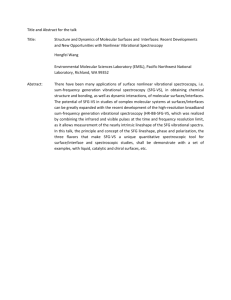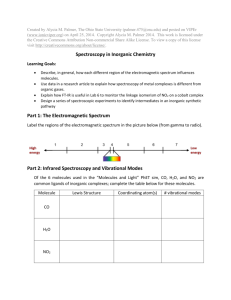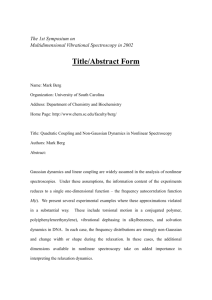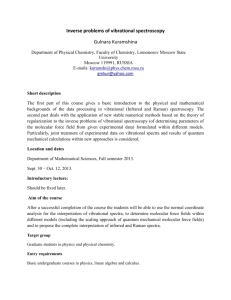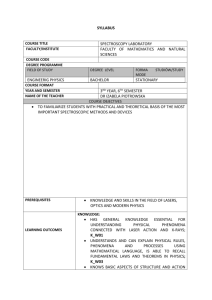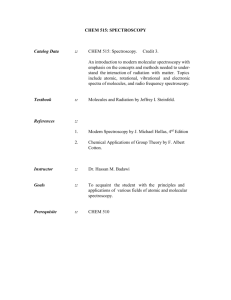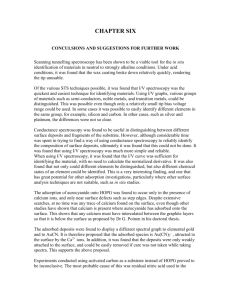Specific - Centre d`Estudis de Postgrau
advertisement
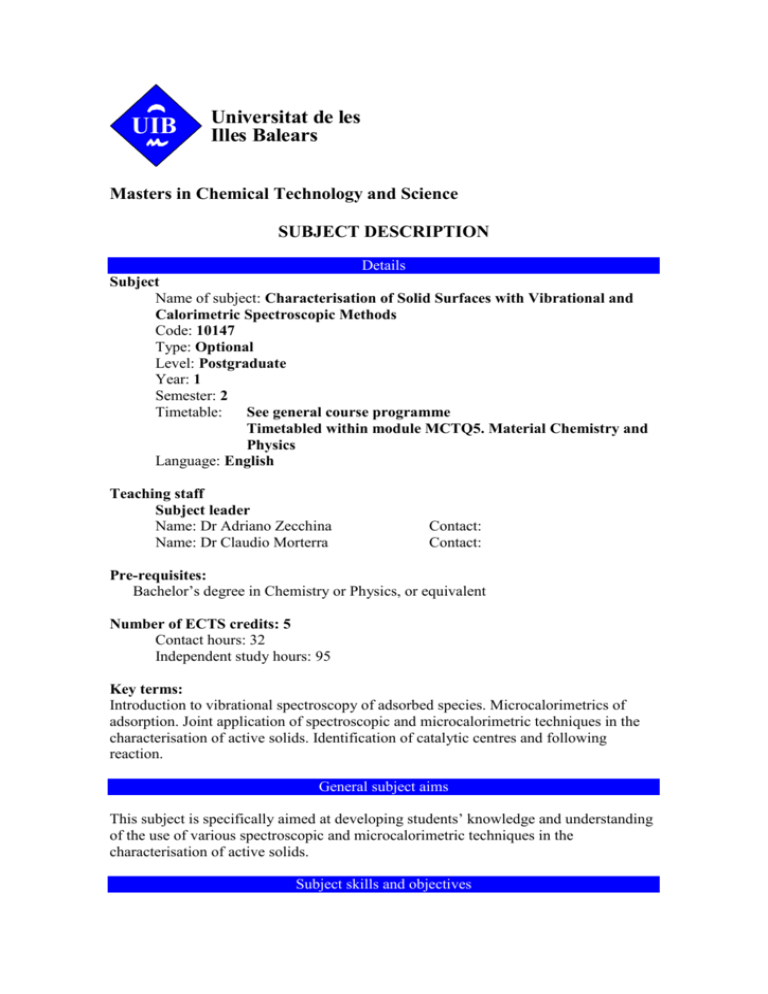
UIB Universitat de les Illes Balears Masters in Chemical Technology and Science SUBJECT DESCRIPTION Details Subject Name of subject: Characterisation of Solid Surfaces with Vibrational and Calorimetric Spectroscopic Methods Code: 10147 Type: Optional Level: Postgraduate Year: 1 Semester: 2 Timetable: See general course programme Timetabled within module MCTQ5. Material Chemistry and Physics Language: English Teaching staff Subject leader Name: Dr Adriano Zecchina Name: Dr Claudio Morterra Contact: Contact: Pre-requisites: Bachelor’s degree in Chemistry or Physics, or equivalent Number of ECTS credits: 5 Contact hours: 32 Independent study hours: 95 Key terms: Introduction to vibrational spectroscopy of adsorbed species. Microcalorimetrics of adsorption. Joint application of spectroscopic and microcalorimetric techniques in the characterisation of active solids. Identification of catalytic centres and following reaction. General subject aims This subject is specifically aimed at developing students’ knowledge and understanding of the use of various spectroscopic and microcalorimetric techniques in the characterisation of active solids. Subject skills and objectives Specific: Have an overall view of the various spectroscopic and microcalorimetric techniques applicable to the study of the surface of active solids. Be able to understand pertinent theoretical principles and their application. Handle spectroscopic and microcalorimetric techniques applicable to the study of the surface of active solids. Be able to interpret and discuss results obtained appropriately. Be able to begin research in the study of the surfaces by means of spectroscopic and microcalorimetric techniques. General: Be able to apply knowledge to practice. Be able to analyse information and synthesise concepts. Be able to communicate with others and work as part of team. Be able to work individually and plan and manage time. Content A. Oxide systems: 10 hours 1. Vibrational spectrum of a metallic oxide and its superficial components 2. Aspects of vibrational spectroscopy of superficial functions: dependence on chemical and physical variables 3. Use in the study of superficial properties of adsorbed signal molecules 4. How to gain quantitative information on adsorbed species from vibrational spectra. 5. Thermodynamic aspects of surface phenomena 6. Calorimetric and non-calorimetric determinations of adsorption heat 7. Combined use of IR spectroscopy and microcalorimetric data B. Metals: 7 hours 1. Vibrational spectroscopy of adsorbed molecules in disperse metals 2. Vibrational spectroscopy of adsorbed molecules on crystalline surfaces 3. Application of EELS to the study of adsorbed species 4. Vibrational spectroscopy of reactions in metallic surfaces C. Experimental methods: 3 hours 1. Vibrational spectroscopy of catalysts under “operando” condition: FTIR and Raman spectroscopy (polymerisation of alkenes and alkynes) Methodology and student work plan 1. Learning methods: Attendance at theory classes. Class work Group size: intermediate 2. Learning methods: Attendance at practical classes. Class work Group size: intermediate 3. Learning methods: Study/preparation for theory classes, problems, seminars etc. Independent study Use of e-learning: Information on the web, e-mail 4. Learning methods: Study/preparation for practical classes Independent study Use of e-learning: Information on the web, e-mail 5. Learning methods: Preparation for and completion of coursework Independent study Use of e-learning: Information on the web, e-mail Learning agreement and assessment criteria and instruments Assessment criteria: 1. Continuous assessment by means of scientific discussion promoted throughout the course (25%) 2. Ability to interpret and discuss experimental results (25%) 3. Coursework (25%) Is assessment organised by means of a learning agreement? No Bibliography, resources and appendices General L. H. Little, Infrared Spectra of Adsorbed Species, Academic Press, London, 1966. M. D. Fayer (Ed.), Ultrafast Infrared and Raman Spectroscopy, Marcel Dekker, N. Y., 2001. Specific S. Bordiga, C. Lamberti, G. Turnes Palomino, F. Geobaldo, D. Arduino, A. Zecchina, Nitrosylic complexes in Ag(I)-ZSM-5: A comparison with Cu(I)ZSM-5; Microporous Mesoporous Mater. 30 (1999) 129-135. V. Bolis, S. Bordiga, G. Turnes Palomino, A. Zecchina, C. Lamberti, Calorimetric and spectroscopic study of the coordinative unsaturation of copper(I) and silver(I) cations in ZSM-5 zeolite - Room temperature adsorption of NH3; Thermochim. Acta 379 (2001) 131-145. C. Morterra, G. Cerrato, V. Bolis, S. Di Ciero, M. Signoretto, On the strength of Lewis- and Brønsted-acid sites at the surface of sulfated zirconia catalysts; J. Chem. Soc., Faraday Trans. 93 (1997) 1179-1184. V. Bolis, G. Cerrato, G. Magnacca, C. Morterra, Surface acidity of metal oxides. Combined microcalorimetric and IR-spectroscopic studies of variously dehydrated systems; Thermochim. Acta 312 (1998) 63-77. B. Bonelli, B. Onida, B. Fubini, C. Otero Areán, E. Garrone, Vibrational and thermodynamic study of the adsorption of carbon dioxide on the zeolite NaZSM-5; Langmuir 16 (2000) 4976.
